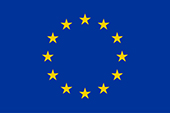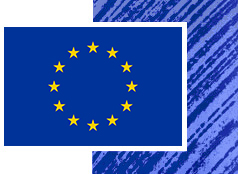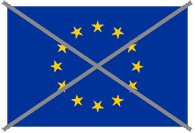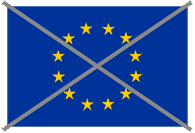Annex A1 Graphics guide to the European emblem
Council of Europe • European Commission
The European flag
The European flag is not only the symbol of the European Union, but also of Europe’s unity and identity in a wider sense. The circle of gold stars represents solidarity and harmony between the peoples of Europe.
The number of stars has nothing to do with the number of Member States. There are 12 stars because the number 12 is traditionally the symbol of perfection, completeness and unity. The flag therefore remains unchanged regardless of EU enlargements.

History of the flag
Since its foundation in 1949, the Council of Europe has been aware of the need to give Europe a symbol with which its inhabitants can identify. On 25 October 1955, the Parliamentary Assembly made the unanimous decision to adopt a circle of 12 gold stars on a blue background as an emblem. On 8 December 1955, the Committee of Ministers adopted this as the European flag.
The Council of Europe’s Parliamentary Assembly repeatedly expressed the desire that other European institutions should adopt the same symbol in order to strengthen the idea of solidarity between the different organisations in a united and democratic Europe.
It was the European Parliament that took the initiative for a flag to be adopted for the European Community. A draft resolution was presented in 1979, shortly after the first European elections held by universal suffrage. In a resolution adopted in April 1983, the Parliament decreed that the Community’s flag should be that adopted by the Council of Europe in 1955. The European Council, meeting at Fontainebleau in June 1984, stressed the importance of promoting the European image and identity in the eyes of its citizens and the world. Then, in Milan in June 1985, it gave its approval to the proposal of the Committee on a People’s Europe (Adonnino Committee) that a flag should be adopted by the Community. The Council of Europe agreed to the use, by the Community, of the European flag that it had adopted in 1955, and Community institutions have been using it since the beginning of 1986.
Thus the European flag and emblem represent both the Council of Europe and the European Union. It has now become the symbol par excellence of a united Europe and European identity.
The Council of Europe and the institutions of the European Union have expressed satisfaction with the growing awareness of the European flag and emblem among European citizens. The European Commission and the Council of Europe are responsible for ensuring that all uses of this symbol respect the dignity of the European flag and emblem, and for taking whatever measures are necessary to prevent misuse.
Introduction
This graphics guide is intended to help users reproduce the European emblem correctly. It includes instructions on how to create the emblem and a definition of the standard colours.
Symbolic description
Against the background of blue sky, 12 golden stars form a circle, representing the union of the peoples of Europe. The number of stars is fixed, 12 being the symbol of perfection and unity.
Heraldic description
On an azure field a circle of 12 golden mullets, their points not touching.
Geometrical description
The emblem is in the form of a blue rectangular flag of which the fly is one and a half times the length of the hoist. Twelve gold stars situated at equal intervals form an invisible circle whose centre is the point of intersection of the diagonals of the rectangle. The radius of the circle is equal to one third of the height of the hoist. Each of the stars has five points, which are situated on the circumference of an invisible circle whose radius is equal to one eighteenth of the height of the hoist. All the stars are upright – that is to say, with the top point vertical and two points in a straight line at right angles to the mast.
The circle is arranged so that the stars appear in the position of the hours on the face of a clock. Their number is invariable.

Regulation colours
The emblem
The colours of the emblem are Pantone Reflex Blue for the surface of the rectangle and Pantone Yellow for the stars. The international Pantone range is very widely available and easily accessible, even for non-professionals.

Four-colour process
If the four-colour process is used, it is not possible to use the two standard colours. It is therefore necessary to recreate them using the four colours of the four-colour process. Pantone Yellow is obtained by using 100 % ‘Process Yellow’. By mixing 100 % ‘Process Cyan’ with 80 % ‘Process Magenta’ one can get a colour very similar to Pantone Reflex Blue.
Internet
Pantone Reflex Blue corresponds to the web-palette colour RGB: 0/51/153 (hexadecimal: 003399) and Pantone Yellow corresponds to the web-palette colour RGB: 255/204/0 (hexadecimal: FFCC00).
Monochrome reproduction process
If only black is available, outline the rectangle in black and print the stars in black on white.
If blue is the only colour available, use Reflex Blue at 100 % for the rectangle and leave the stars in white (negative).

Reproduction on a coloured background
The emblem is preferably reproduced on a white background. Avoid a background of varied colours, and in any case one that does not go with blue. If there is no alternative to a coloured background, put a white border around the rectangle, with the width of this being equal to one twenty-fifth of the height of the rectangle.

Examples of incorrect reproduction
| 1. The emblem is upside down. |  |
| 2. The stars are not upright. |  |
| 3. The stars are wrongly positioned in the circle: they must appear in the position of the hours on the face of a clock. |  |
Use by third parties
The principles of use of the European emblem by third parties have been set out in an administrative agreement with the Council of Europe. This agreement was published in the Official Journal of the European Union (OJ C 271, 8.9.2012, p. 5).
In accordance with this agreement, any natural or legal person (‘third-party user’) may use the European emblem or any of its elements, as long as this use:
If the use of the European emblem complies with the above conditions, there is no need to ask for written permission.
Registration of the European emblem, or a heraldic imitation thereof, as a trade mark or as any other intellectual property right is not acceptable.
For questions related to the use of the European emblem, see:
https://europa.eu/european-union/abouteuropa/legal_notices_en#emblem
Requests from non-EU countries
Council of Europe
Directorate of Legal Advice and Public International Law (Dlapil)
67075 Strasbourg Cedex
FRANCE
Tel. +33 388412000
Fax +33 388412052
Email: legal.advice@coe.int
Originals for reproduction are available for downloading
at:
http://europa.eu/about-eu/basic-information/symbols/flag/index_en.htm


